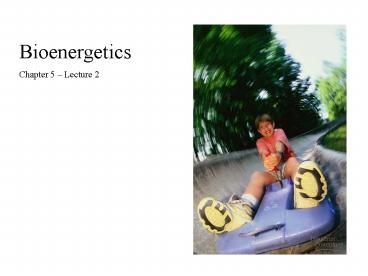Bioenergetics - PowerPoint PPT Presentation
1 / 18
Title: Bioenergetics
1
Bioenergetics Chapter 5 Lecture 2
2
Lecture 2
- More on enzymes
- Redox Reactions
- Introduction to Respiration
3
Enzymes are very specific
Each enzyme generally only works with one set of
substrates Enzymes have a particular set of
environmental conditions at which they work best
(i.e. temperature, pH, salt concentration)
Example 1 Most human enzymes work best at 35 to
40 C. Enzymes of bacteria found in hot springs
work best at 60 to 70 C Example 2 Most human
enzymes work best at pH between 6 to 7. The
digestive enzyme pepsin which is found in the
very acidic environment of the stomach works best
at a pH of 2.
4
Enzymes can be inhibited in a variety of ways
Many pesticides and antibiotics work by
inhibiting certain essential enzymes in the
target species
5
Allosteric Regulation
Allosteric site specific receptor site on some
part of the enzyme molecule other than the active
site.
Active conformation Inactive
Conformation
6
Introduction to Redox Reactions
Oxidation-Reduction reactions chemical
reactions that involve the partial or complete
transfer of electrons from one reactant to
another. a.k.a redox reactions
7
More Redox
8
Introduction to Cellular Respiration
Cellular Respiration is a biochemical process
that aerobically harvests energy from food
molecules in the cell
9
Breathing vs Cellular Respiration
10
Cellular Respiration is a Redox Process
Oxidation
Reduction
11
(No Transcript)
12
Cells tap energy from electrons transferred from
organic fuels to oxygen
13
(No Transcript)
14
Redox reactions release energy when electrons
fall from a hydrogen carrier to Oxygen
At the beginning of the next set of reactions all
the NADH gives up its energetic electrons and
NAD is regenerated
15
Electron Transport Chain
16
Two Mechanisms Generate ATP
17
Chemiosmosis
18
Substrate-level Phosphorylation































